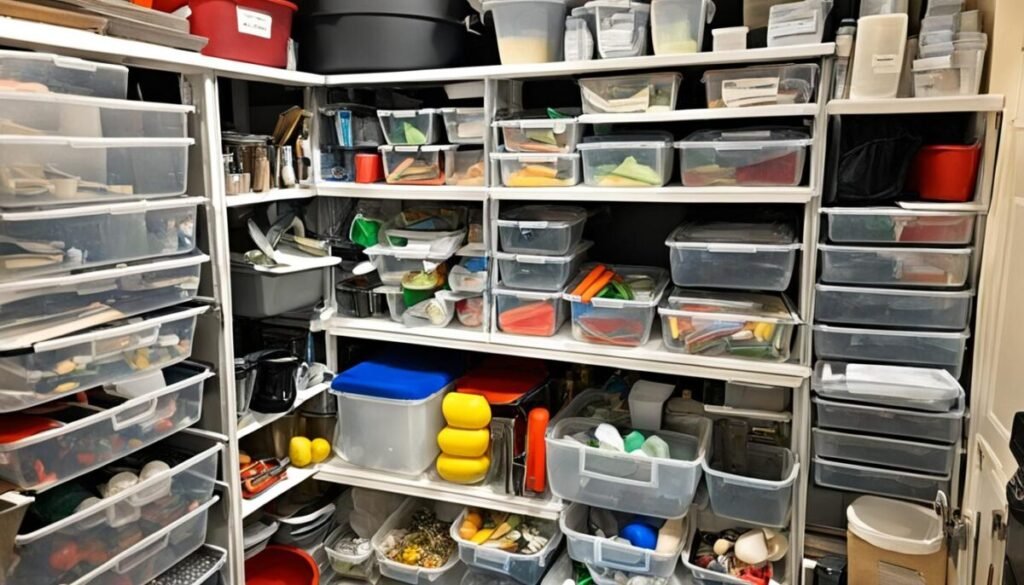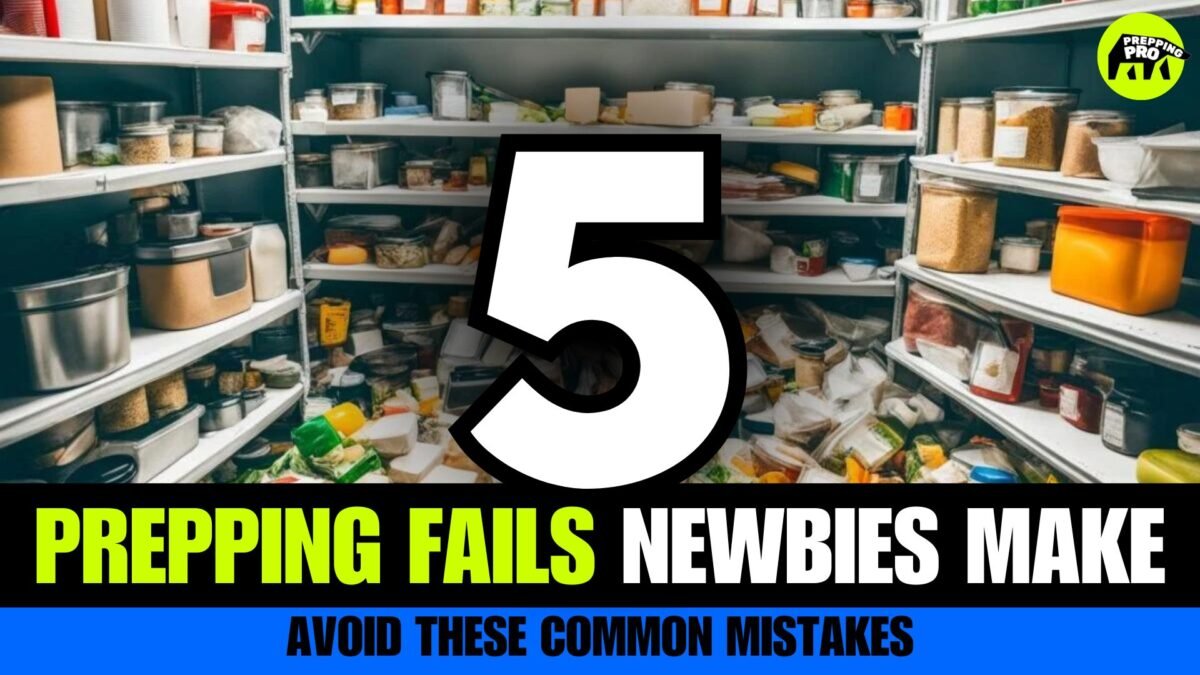Benjamin Franklin once said, “By failing to prepare, you are preparing to fail“.
In this article, you’ll learn about these common prepping mistakes for beginners and receive insights on how to avoid them.
Common mistakles like understanding proper food storage, maintaining fantastic physical fitness, or a simple misunderstanding of procuring the right gear—these pitfalls among common prepping mistakes for beginners are often, thankfully, avoidable.
So let’s get started and dive into the world of prepping without making those typical prepping mistakes for newbies.
Table of Contents
Understanding Common Prepping Mistakes for Beginners

As with any new endeavor, learning to navigate the world of prepping is rife with potential pitfalls.
However, understanding common prepping mistakes beginners often make can help to avoid them, ensuring that your survival course is set on a solid and sound track.
Recognizing the Intricacies of Survival Preparations
Prepping is not just about stockpiling goods. It involves comprehensive planning that includes assessing potential risk scenarios, strategising a suitable course of action, and diligently adhering to it. Nuance matters.
The Pitfalls of Overlooking Medical Issues and Fitness
A common error among novices is failing to account for health and fitness.
Physical well-being and medical readiness, often overlooked, are of paramount significance in survival scenarios. Ignoring them can severely jeopardize your survival strategies even before you face a situation.
Averting the Compulsion to Overbuy Prepping Gear
Another common prepping mistake newcomers should avoid is the compulsion to overbuy gear. While having the right equipment is crucial, knowing what is truly essential comes with experience.
Having walls full of gear is meaningless if you don’t know the value of each piece and how to use it effectively. Therefore, buying gear should be a calculated decision, not an impulsive one.
Understanding the realm of prepping beyond its surface enables beginners to circumvent most of the common prepping errors.
The adventure of transitioning from a novice to a seasoned prepper, one might say, lies not only in how well you prepare, but also how well you learn from your mistakes. Remember, in prepping like in life, consistent learning is key.
Mistake 1: They Tackle Canning Wrong

There is no denying it: prepping for survival is a journey of learning, constant adapting, and nuance.
One of the most common prepping mistakes for beginners dwells right in the heart of food preservation—the seemingly simple yet tricky art of canning.
An unforeseen misstep I often notice among newcomers is the reuse of canning lids. Granted, it may seem like a financially and environmentally sound decision. But this can, in fact, lead to something far more sinister—food spoilage.
Minor damages like dents or cracks obtained from the first usage could allow air to sneak into your meticulously canned foods. The resulting spoilage compromises the quality of your food reserve at a time when you might need it most.
Not an ideal scenario when you’re aiming for long-term survival, right?
The silent assassin here is not conspicuous shortcomings, rather it’s the silent, usually overlooked fault lines.
This emphasizes why it’s vital to use new lids for each canning session. Just as we value the quality of food being preserved, the tools used hold equal significance.
Addressing such beginner prepper errors in canning isn’t merely about avoiding a minor hiccup.
It’s about integrating stringent food safety measures, a critical part of prepping. Such crucial steps aid in ensuring your hard-earned efforts don’t end up being for naught.
Mistake 2: They Don’t Account for Physical Fitness in Survivalism
One of the most common mistakes in prepping for beginners lies in overlooking physical fitness.
Day-to-day life seldom prepares us for the rigors of survival situations, and the assumption that mental preparation and gear alone suffice is a frequent error.
For those learning the ropes, it’s essential to realize that the power of a well-prepared mind is amplified by a trained body.
Understanding the importance of fitness isn’t just about knowing it’s necessary—it’s about integrating it into your survival plan.
Fitness is the fulcrum upon which your survival chances pivot, and without regular exercise and attention to health, your prep might fall short in the face of adversity.
No matter how much you fortify your shelter or stockpile supplies, it’s your health and fitness that withhold the ultimate burden of survival.
Let’s dive into a few of these fitness-related beginner prepper errors and how to fix them:
| Error | Solution |
|---|---|
| Neglecting physical health | Integrate a fitness routine into your prepping plan, focusing on endurance and strength exercises. |
| Ignoring existing health conditions | Seek medical advice and treatment for pre-existing conditions that could impede your survival capacity. |
To sum it up, the connection between physical capacity and survival likelihood can’t be overstated. Remember, your body is the ultimate survival tool. Keep it tuned, and it’ll carry you through the toughest situations.
Mistake 3: They Make Food Storage Blunders
Another mistake that beginner preppers often make is not properly storing their food items. This can include failing to use airtight containers or not considering the impact of temperature and moisture on food spoilage.
Without proper storage, food can easily become contaminated, leading to waste and potential health risks.
Additionally, some new preppers forget to diversify their food storage. They may focus on storing only one type of food, such as beans or rice, without considering the need for a variety of nutrients in their diet. This can lead to a lack of essential vitamins and minerals, negatively impacting their overall health and well-being.
To avoid these common prepping mistakes for beginners, it is important to pay attention to expiration dates and rotate your stock accordingly. Invest in airtight containers and consider the impact of temperature and moisture on food storage. Lastly, diversify your food storage to ensure a well-rounded diet.
By avoiding these blunders, you can effectively prepare for any unexpected events or emergencies that may arise.
One of the more nuanced aspects of prepping is the management of food storage. Beginner preppers often stumble in this area, making several common mistakes.
These errors are avoidable and fixing them can significantly improve your chances of survival during a catastrophe.
Avoid Temperature Fluctuations and Improper Locations
Overlooking the sensitivity of food to temperature variations is a common oversight. For instance, storing food supplies in fluctuating environments like an attic can effectively reduce the shelf life of your stockpile, rendering it ineffective in a critical situation.
A constant, cool temperature is crucial for the preservation of many food types. By ensuring appropriate storage conditions, you adequately safeguard your food supplies and combat a frequent beginner prepper error.
Utilization Water Sources and Purification Correctly
When it comes to hydration, mismanagement of water sources and improper purification are other notable errors. The safety of rainwater and snow as drinking sources, when properly purified, could be life-saving knowledge.
Melting and filtering snow, instead of ingesting it directly, is one of the safer practices beginners should adopt.
Hence, your prepping strategy should ensure comprehensive food and water storage techniques.
Mistake 4: They Don’t Balance Their Stockpile (Water vs. Food)
Prepping is akin to a science, where every element of your stockpile demands equal and precise attention as we prepare for the uncertain.
A common mistake often seen among beginners is an imbalance in their stockpile – usually tilting towards food, while undermining the importance of water.
Both these elements form the bedrock of survival and need to be maintained in a balanced quantity, relative to each other. Before diving into further details, let’s look at the image below which sheds light on the common mistakes in prepping for beginners.
It’s common to prepare for a long-term food shortage, however, what’s often not equally considered are the water needs.
Vital to life, the value of water in survival scenarios cannot be overemphasized. Its affordability, ease of storage and rotation necessitate stocking a supply that balances out the food stash.
Thus, beginner prepper errors often lie in neglecting these crucial aspects.
Maximizing Shelf Life and Accessibility of Water
Another essential consideration is to understand how to manage the shelf life and accessibility of your water supply.
Simply having a large quantity of stockpiled water is not enough; how it is stored, where it is stored, and its rotation schedule are equally important.
Understanding Duration Limits of Stockpiled Resources
Additionally, having a clear understanding of the duration limits of your stockpiled resources can help counteract novice mistakes.
This ensures that your preparations are not futile, and your stockpile can actually support you when the need arises.
Let’s explore this in the table below:
| Resource | Lifespan | Storage tips |
|---|---|---|
| Canned Food | 1-4 years | Store in a cool, dark place |
| Bottled Water | Indefinite, if unopened and stored in appropriate conditions | Keep away from chemicals & gasoline. Store in a cool, dark place |
| Dried Beans | 2-3 years | Store in airtight containers away from light |
Understanding these mistakes and correcting them in time can be a game-changer for new preppers.
Remember, successful prepping isn’t just about amassing supplies – it’s about the right balance, the right understanding, and meticulous planning.
Mistake 5: They Don’t Invest in Gear (Quality Over Quantity)
The significance of investing in quality gear is understated yet pivotal in determining survival preparedness, and this is a glaring prepping mistake beginners should avoid.
My experiences have taught me that simply accumulating equipment without considering their quality can lead to fatal repercussions.
Evaluating Life-Saving Gear vs. Ineffective Purchases
Purchasing gear solely based on price or quantity is an unfortunate beginner prepper mistake to watch out for.
The emphasis should be on purchasing life-saving, robust gear over cheaper yet ineffective alternatives. The solidity of a well-chosen knife, the reliability of a durable water purifier, or the precision of an accurate compass can actually make the difference between life and death in critical survival encounters.
Focusing on Skill Development Alongside Gear Acquisition
While gear is undeniably crucial, it is equally important to focus on skill development.
Mastering survival techniques, learning to use tools efficiently, or even understanding how to fashion makeshift equipment in absence of traditional gear are instrumental abilities that can significantly boost a novice prepper’s confidence and skill set.
Understanding the Shelf Life of Essential Supplies
Not all supplies last forever, and this ever-present reality is something that must be embraced and understood.
Certain vital supplies such as water purification tablets have a restricted shelf life. Hence, strategic decision-making regarding when to use them and when to replace them is an integral part of prepping.
| Supplies | Shelf Life |
|---|---|
| Water Purification Tablets | 5 years |
| MREs (Meals Ready to Eat) | 5 years |
| First Aid Supplies | Varies |
| Batteries | Up to 10 years |
In the realm of prepping, establishing a balance between quality gear investment, honed survival skills, and an understanding of shelf life dynamics of essential supplies is a determinant of the effectiveness of one’s survival readiness. Where novices might falter, an aware and knowledgeable prepper perseveres and prevails.
Conclusion
As a seasoned prepper, I’ve walked through the trials and errors, stumbled over the intricate obstacles, and learned the oft-overlooked intricacies that defining the journey for countless beginners.
These common prepping mistakes for beginners are not mere stumbles. Instead, they serve as stepping stones, critical learning opportunities paving the way for resilience and resourcefulness.
Avoiding prepping mistakes beginners should avoid forms the very backbone of successful survivalism.
It is not just about enduring through crisis situations; it’s more about thriving amidst such challenges—maximizing preparedness, optimizing resources, and leveraging every single lesson for better preparedness in the future.
Guiding newcomers through the labyrinth of common prepping errors for novices is a duty I feel deeply about.
My hope is that, through the exploration of these beginner prepper mistakes to watch out for, you would be better equipped to navigate this essential path, rising above typical trials and preparing efficiently.
Defying the odds, rectifying common mistakes in prepping for beginners, and honing your survival skills is no easy feat.
But by sidestepping these prefabrication mistakes for newbies, you are well on your way to embarking your journey with an enduring confidence and an unbeatable preparedness—the very foundations of an adept prepper.
Here’s to learning from every stumble, to embracing every lesson, and to forging a path marked by resilience and unwavering preparedness. The journey, after all, is as rewarding as the destination.


